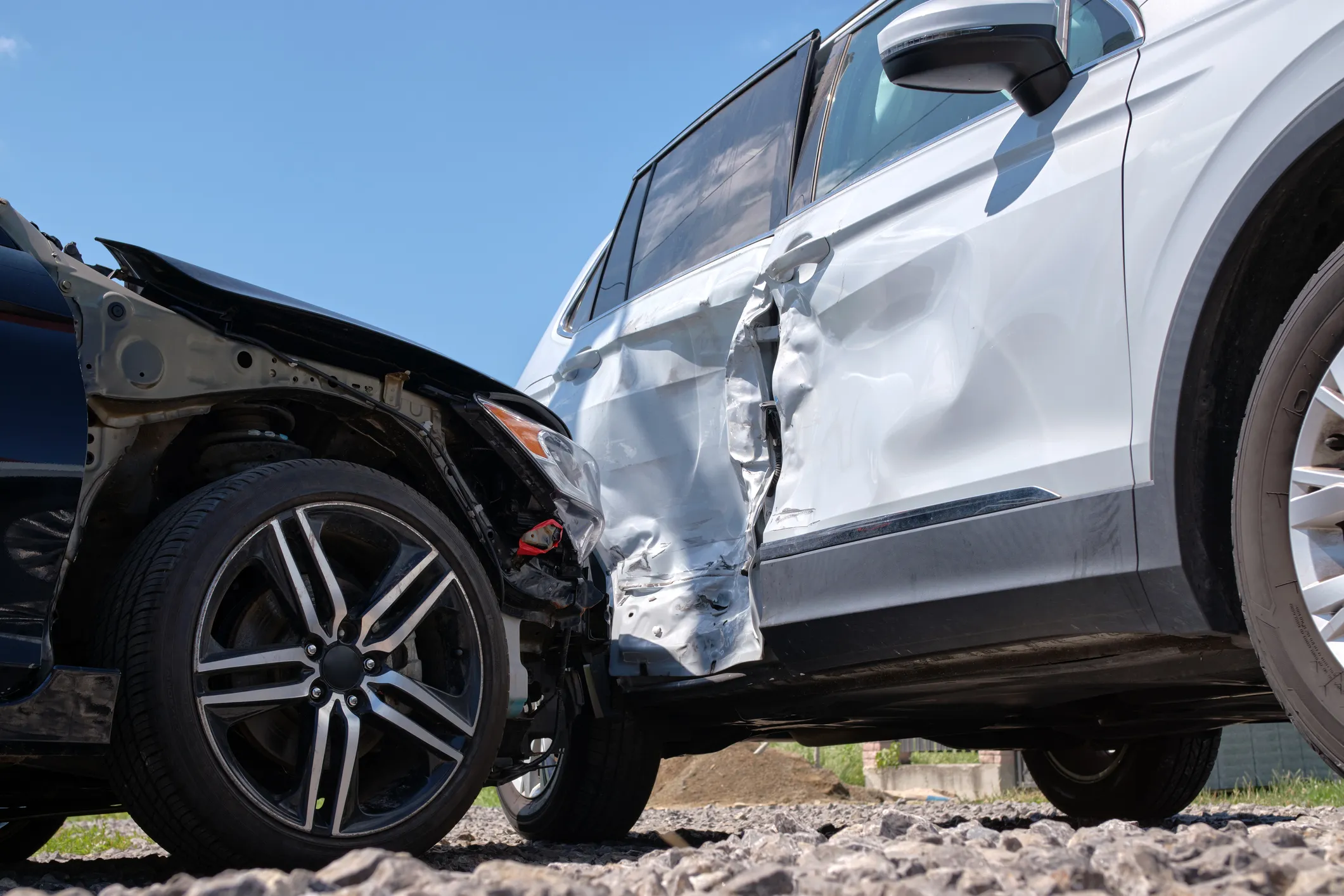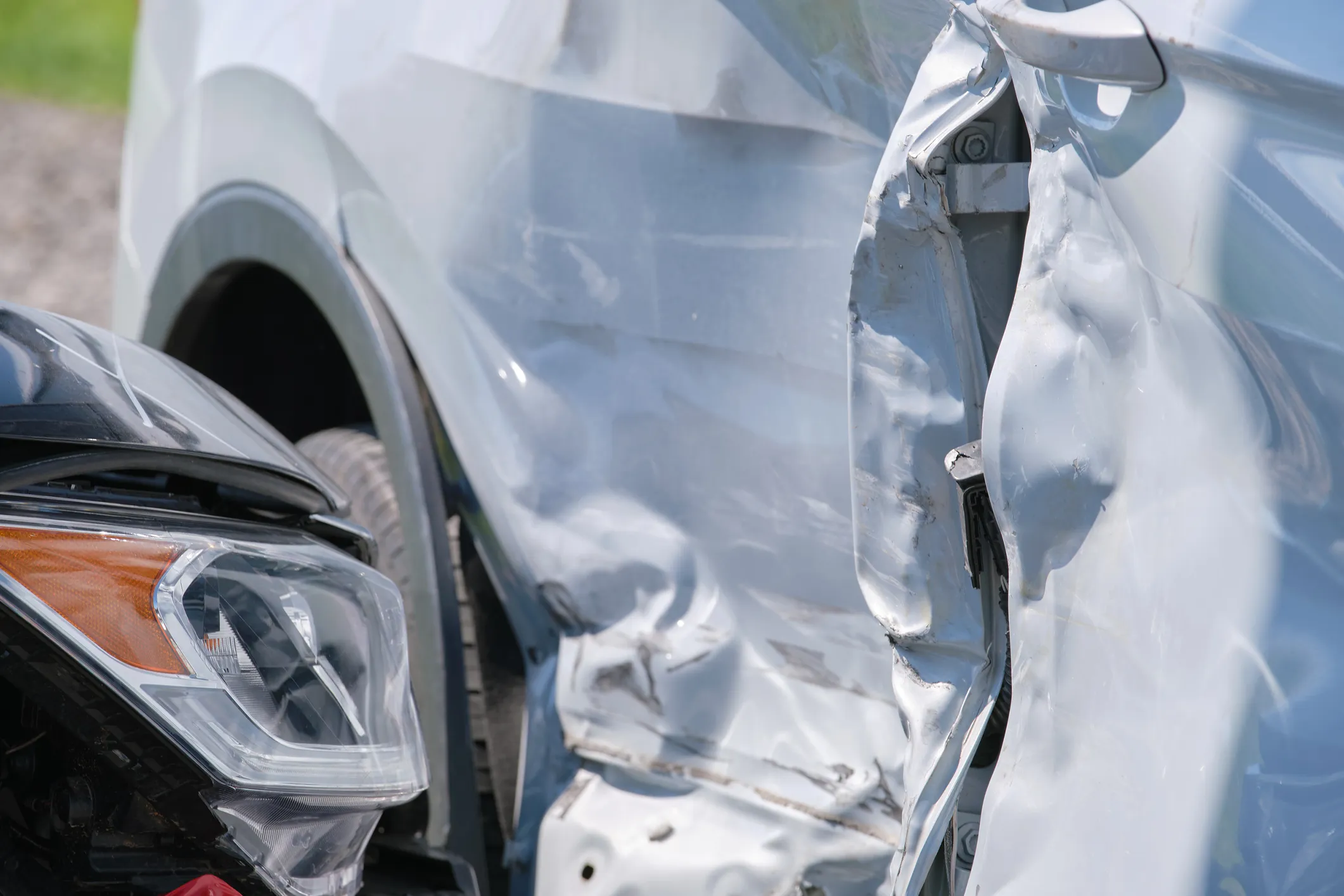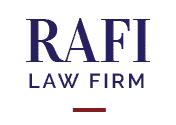Getting “T-boned” can leave vehicle occupants with severe, sometimes permanent, injuries. In the most devastating accidents, occupants can be killed. These injuries cause physical damage as well as emotional trauma and substantial financial distress. A skilled Savannah personal injury lawyer from Rafi Law Firm can help recover those losses.
Following a T-bone accident, connect with a Savannah T-bone accident lawyer from our firm as soon as possible. Your attorney will fight hard to protect your rights and get you compensated so you can move toward recovery and a more stable financial future.

What exactly is a T-bone accident?
T-bones get their name from the shape that vehicles make when they collide.
When two cars collide at a perpendicular angle – usually when the front end of one vehicle hits the side of another vehicle, forming the shape of a “T.”
Other names for this type of accident are broadside, side-impact, or right-angle collisions. They commonly occur at intersections where cars cross each other’s paths.
Why are T-bones so dangerous?
It is easy to recognize the dangers of T-bone accidents. While car occupants on the side of the car hit broadside are hopefully seat belted and protected by the vehicle’s safety features, they are still in a position to take a direct hit. Even those on the other side sustain powerful jolts that can cause significant damage.
The dangers to drivers and passengers in a T-bone accident
Drivers or passengers sitting on the side of the car that is hit in a T-bone accident are at greatest risk for severe or fatal injuries.
For a recent full year of data collection, the National Safety Council (NSC) shows that angle collisions (T-bones) caused the highest number of fatalities in accidents involving other motor vehicles. T-bone accidents accounted for 9,000 deaths, representing 44.8% of fatalities from crashes with other cars.
For comparison, head-on collisions, which represent the next-highest category for fatalities, produced 5,900 or 29.4%. Angle accidents caused 1,894,000 injuries, while rear-end accidents, the next highest category for injuries, caused 1,597,000.
Additional cars involved
When additional cars are involved, perhaps crashing into the T-boned vehicles, the chances for severe injury and death rise.
Further impact causes further opportunity for jolts to the head, neck, back, or any other part of the body or for crushing vehicles against each other and the passengers inside with even more force.
What are some common causes of T-bone accidents?
You cannot collect a settlement unless you identify the cause, determine the at-fault party, and compile evidence to prove that party’s negligence. Trust a Savannah T-bone accident from Rafi Law Firm to investigate your situation and hold the responsible party accountable.
Failure to yield the right-of-way
Sometimes drivers think they are the only ones in a hurry and rather than yielding right-of-way at a stop sign, perhaps, they rush through before their turn. Drivers must also yield right-of-way when backing out of parking spots. When they do not, they put their cars in the “perfect” position to be T-boned by drivers already proceeding through their lane of the parking lot.
Failure to yield can be accidental. It may not be clear whose turn to proceed through the stop sign, or drivers may not see cars approaching as they back out of a space.
Running a red light
Racing through a light “just before” it turns red usually equates to running a red light–an extremely dangerous driving action. While some drivers may fortunately see the light-runner before a crash occurs, others do not have that opportunity. As traffic laws warrant, they proceed through their “new” green light and are surprised by the car racing through the now-red light.
Since cars typically do not run red lights at slow speeds, the crash’s impact is likely to be serious, and the unsuspecting drivers and passengers in the other vehicle are vulnerable to severe injury.
Turning across traffic lanes
Drivers making a left turn across lanes of oncoming traffic must yield to that oncoming traffic. More aggressive drivers may rush the turn, trying to “beat” the oncoming car, and fail. Other times, left-turning drivers may misjudge the speed and distance of oncoming vehicles.

Distracted driving
Texting and driving, holding and talking on a phone while driving, or scrolling while driving has led to higher accident rates, including T-bone accidents.
Sending or reading a text takes a driver’s attention off the road for five seconds, according to the National Traffic Safety Highway Administration (NHTSA), which is the equivalent of driving with closed eyes for the length of a football field. Distracted driving cost 3,522 people their lives in a recent year, the NHTSA reports.
Cell phones are not the only distractions taking drivers’ eyes off the roads. Eating, adjusting music or climate, engaging in active discussions, or enjoying the landscape can cause drivers to run lights, miss stop signs, or make unwise turns, resulting in side-impact accidents.
Reckless or aggressive driving
Reckless or aggressive drivers do not seem to care about what is happening around them. Whether racing or in a hurry, they ignore traffic lights or stop signs, make unsafe turns, or lose control of their vehicles after weaving dangerously through traffic.
Impaired driving
Driving with a blood alcohol concentration (BAC) of .08% or higher is illegal in Georgia. However, even drivers with a lower BAC who show signs of impairment can be charged with driving under the influence (DUI).
Drunk drivers have slower reaction times and are less aware of their surroundings. They are more likely to drive recklessly and ignore traffic signals, behaviors contributing to T-bone accidents.
Inattentive pedestrians or cyclists
Distraction does not just affect drivers. Pedestrians busy texting or scrolling or otherwise taking their eyes off the road and the vehicles in their surroundings can cause T-bone accidents. Cars may swerve or stop to avoid hitting the inattentive walkers and get rammed broadside.
Pedestrians have responsibilities in Georgia, and failure to comply with those regulated responsibilities can lead to serious traffic accidents.
Cyclists have to follow the same rules of the road as drivers, though not all do. If a cyclist comes to a four-way stop sign but does not stop, a car may have to stop mid-intersection to avoid hitting the cyclist and get T-boned while in that vulnerable position.
Hazardous weather conditions
Drivers must take extra care when operating vehicles in hazardous weather, such as heavy rain, high winds, or fog. In doing so, they can protect themselves from hydroplaning or skidding on slick surfaces and finding themselves in a position to be broadsided or have time to avoid T-boning another vehicle that has lost control.
Mechanical failures
Drivers cannot control vehicles experiencing mechanical failure, and such failures often lead to accidents. T-bones are likely if a car’s brakes fail, preventing the driver from stopping at a red light. Though unintentional and despite the driver’s efforts to stop, the vehicle has run a red light–or other signal–presenting the frightening opportunity for a side-impact accident.
Unsafe road conditions
Government offices are responsible for maintaining roads safe for travel. Roads littered with construction debris or riddled with potholes pose dangers. It is easy to skid and get turned halfway around after hitting a patch of loose gravel or blowing out a tire after hitting a pothole.
Fatigued driving
The NSC explains fatigued driving can be as dangerous as driving under the influence. Drivers’ reaction times slow down the drowsier a driver becomes, and driving after not sleeping for 20 hours is equivalent to driving with an over-the-limit BAC. Drivers can nod off for a “micro-sleep,” even as short as four to five seconds, and experience and produce the same dangers as one who sends a text.
In its discussion, the NSC reports a study conducted by the AAA Foundation for Traffic Safety which “estimates 328,000 drowsy driving accidents occur annually.”
Who is at fault in a T-bone accident?
Though you may think the party at fault for causing your accident is obvious, it takes more than initial thoughts or observations to truly determine who should be held responsible. Your Savannah T-bone accident lawyer will find out why your accident occurred and who ultimately caused it.
Measurement of fault
Measuring fault is an important part of the personal injury process. In Georgia, personal injury claims follow a comparative fault structure, which means victims can only pursue damages if they are less than 50% responsible for causing the accident leading to those damages.
If they meet that standard of fault but still hold some percentage of blame, they collect a reduced settlement according to that percentage. Should a victim be 10% to blame and their total calculated settlement is $200,000, they would collect $180,000.
Assignment of fault
The at-fault party’s insurance and other representatives will do their very best to assign as much fault to you or someone else who is “not them” to reduce their payout. The tactics they use include intimidating victims, twisting victims’ words into admissions of fault, and presenting versions of the accident that suit their agenda.
Do not fall prey to these predatory strategies. Count on your lawyer to handle all discussions of fault with the insurance companies. Rafi Law Firm is onto these insurance companies’ tricks and will fight to protect you from unfair settlement reductions.
Investigation of fault
Your lawyer will protect you from these unfair reductions with evidence collected from the accident investigation. Rafi Law Firm has resources, such as connections with accident reconstructionists and other experts and experience handling accident investigations.
We will proactively find the evidence to support your claim against the at-fault party and your settlement demand.
Trial
Usually, personal injury cases, including T-bone accidents, are settled out of court. Your Savannah T-bone accident lawyer will negotiate with your insurance company until you reach a fair settlement amount.
If the at-fault party refuses to agree to a fair deal, do not worry. Your attorney will advise you of your options. Should you take your case to trial, your lawyer will offer superior representation at all court proceedings.
Our Savannah T-bone accident lawyers are ready to help
To ensure you are treated fairly and get the settlement you deserve, partner with Rafi Law Firm. Our Savannah T-bone accident lawyers are here for you and are ready to help. Call (912) 461-6798 for a free consultation with a compassionate, knowledgeable attorney. Our help comes with no risk to you. We only take fees once we secure a settlement.




